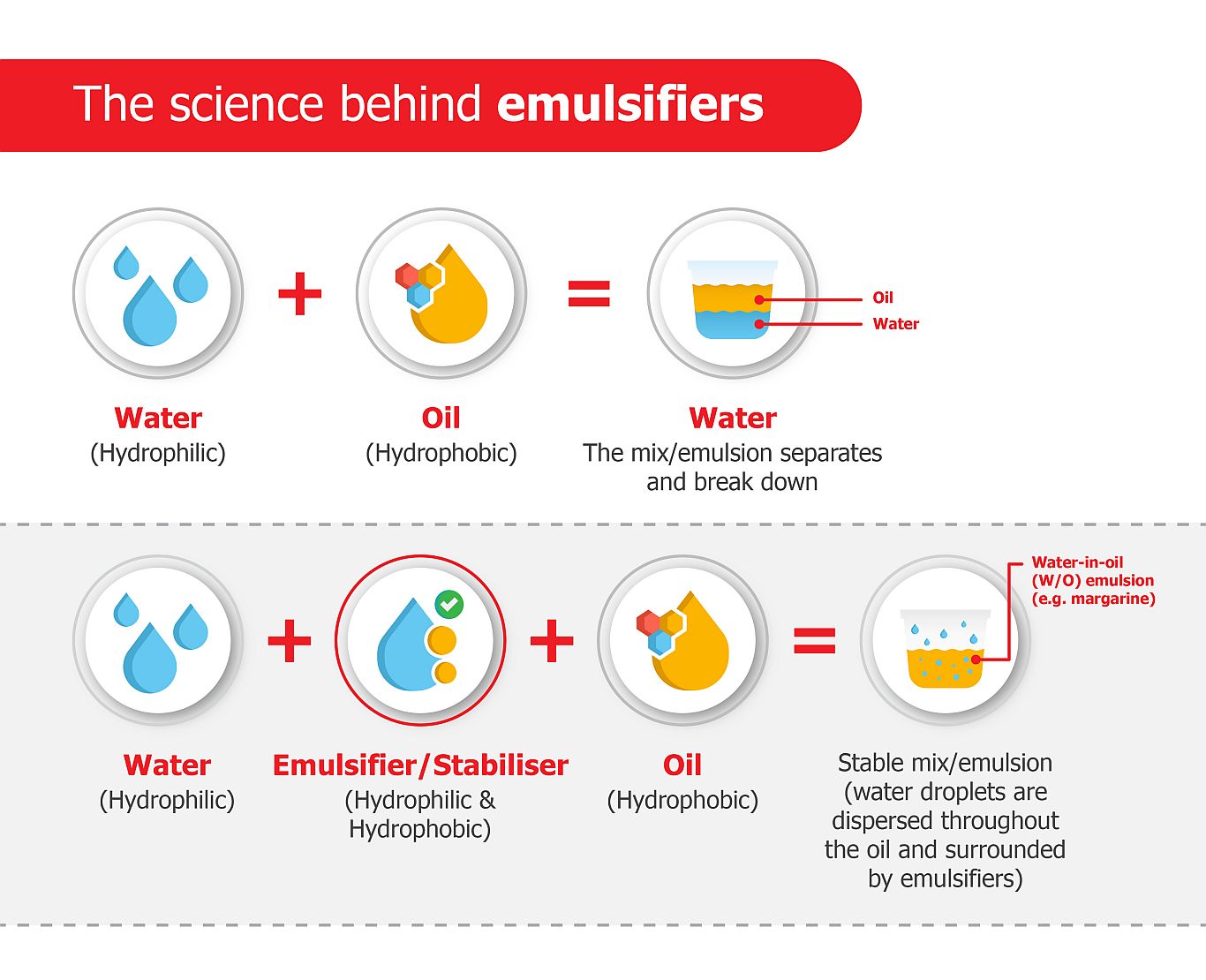Find out Just How an Emulsifier in Food Can Aid Achieve Perfectly Combined Dishes Every Time
Emulsifiers are crucial components in the cooking world, making it possible for the blending of oil and water-based components. Their capability to minimize surface stress enables the production of secure blends, improving both texture and taste in numerous recipes. Understanding exactly how these compounds function can change the way one approaches cooking. Lots of continue to be uninformed of the various kinds of emulsifiers and their details applications. Exploring this subject reveals beneficial insights for accomplishing cooking excellence.
What Are Emulsifiers and Just How Do They Work?
Emulsifiers play a necessary function in the food sector by allowing the steady blending of components that usually do not combine, such as oil and water. These materials have both hydrophilic (water-attracting) and hydrophobic (water-repelling) homes, enabling them to communicate with both types of active ingredients. When an emulsifier is added to a combination, it lowers the surface area tension between the oil and water, facilitating the development of tiny droplets of one fluid distributed within the various other. This procedure develops a stable solution, stopping separation over time and enhancing texture and mouthfeel. Emulsifiers are fundamental in different food, from salad dressings to gelato, making sure uniformity and high quality. They likewise add to the overall sensory experience of food, influencing flavor release and visual appeal. Understanding just how emulsifiers function is essential for food researchers and cooks alike, as they venture to develop delightful and well balanced culinary experiences.
Usual Kinds of Emulsifiers Used in Cooking
Many kinds of emulsifiers are utilized in cooking to achieve desired structures and stability in different foodstuff. Usual emulsifiers include lecithin, which is normally found in egg yolks and soybeans, and is widely made use of in mayonnaise and dressings. One more widespread emulsifier is mustard, which includes substances that help mix oil and water in sauces.
In addition, commercial emulsifiers such as mono- and diglycerides are usually included in processed foods to boost their security and enhance service life. Starch-based emulsifiers, derived from corn or potatoes, are also employed in gravies and desserts for enlarging and texture. Casein, a milk healthy protein, offers as an emulsifying representative in milk products like cheese and cream. Each of these emulsifiers plays a crucial duty in ensuring that active ingredients mix seamlessly, supplying the preferred uniformity and flavor in cooking creations.
The Scientific research Behind Emulsification
:max_bytes(150000):strip_icc()/salad-dressings-2500-57ad12295f9b58b5c2484d0a.jpg)
The stability of an emulsion depends on the equilibrium between the pressures acting on the spread beads. If the droplets integrate, the emulsion can damage, leading to splitting up. Various aspects, such as temperature, focus of the emulsifier, and the approach of blending, influence the success of emulsification. Comprehending this clinical structure is essential for achieving regular results in cooking applications entailing solutions.
Tips for Utilizing Emulsifiers in Your Recipes
When integrating emulsifiers right into recipes, careful consideration of their buildings and functionality can considerably enhance the final item. Initially, one should pick the proper emulsifier based on the wanted appearance and stability of the dish. Emulsifier In Food. Typical choices include mustard, egg, and lecithin yolks, each offering special advantages
It's necessary to recognize the temperature at which the emulsifier operates ideal; for instance, some emulsifiers work effectively at space temperature, while others need warm. Slowly including oil to the emulsifier while whisking can aid develop a secure solution.
In addition, the proportion of emulsifier to fluid is vital; inadequate might cause splitting up, while way too much can create an unfavorable appearance. Correct storage space conditions should be thought about, as some emulsified items may require refrigeration to click to find out more preserve security and quality. By following these suggestions, chefs can attain consistently well-blended recipes.

Delicious Recipes Featuring Emulsifiers
While numerous cooks may not realize it, incorporating emulsifiers into dishes can boost meals to new heights of flavor and appearance. As an example, a timeless vinaigrette advantages considerably from the addition of mustard, which serves as an emulsifier, offering a smooth consistency that binds oil and vinegar seamlessly. Homemade mayo showcases the power of egg yolks, developing a velvety, elegant sauce perfect for salads and sandwiches. - Emulsifier In Food
In baking, emulsifiers like lecithin can aid accomplish a tender crumb in cakes and muffins, enhancing wetness retention. A rich delicious chocolate ganache, made with heavy lotion and chocolate, can also integrate an emulsifier to maintain a smooth finish. In addition, gelato often use emulsifiers to prevent and assure a creamy appearance ice crystal formation, leading to a delightful treat experience. By incorporating these emulsifying agents, chefs can create meals that thrill the taste buds and give a rewarding mouthfeel.
Regularly Asked Questions
Are Emulsifiers Safe for Individuals With Food Allergies?
Emulsifiers can be safe for individuals with food allergic reactions, relying on the particular emulsifier made use of. However, cross-reactivity and private level of sensitivities vary; as a result, getting in touch with a healthcare expert is suggested to guarantee security.
Can I Make My Very Own Emulsifier in the house?
Yes, individuals can create homemade emulsifiers using components like egg yolks, mustard, or honey. These all-natural choices can properly mix oils and water-based parts, offering a simple service for different culinary applications.
Exactly How Do Emulsifiers Impact the Nutritional Value of Food?
Emulsifiers can improve the nutritional value of food by enhancing nutrient absorption and stability. Nevertheless, extreme usage may result in unfavorable impacts, potentially altering food digestion procedures and influencing intestine wellness in delicate individuals.


Exist Any Type Of Adverse Negative Effects of Consuming Emulsifiers?
Some studies suggest that eating emulsifiers may bring about gastrointestinal concerns or disrupt digestive tract microbiota balance. Further research study is required to totally understand their long-lasting results on health and prospective unfavorable side results.
Can Emulsifiers Change the Flavor of My Dishes?
Emulsifiers can discreetly modify the flavor profile of recipes. By boosting appearance and mouthfeel, they may make flavors a lot more obvious or well balanced, however they normally do not convey solid tastes by themselves.
Emulsifiers play a necessary duty in the food sector by enabling the stable mixing of ingredients that usually do not incorporate, such as oil and water. Countless kinds of emulsifiers are made use of in food preparation to achieve desired textures and stability in various food products. Additionally, commercial emulsifiers such as mono- and diglycerides are frequently added to processed foods to enhance their stability and improve shelf life. It's essential to understand continue reading this the temperature at which the emulsifier operates ideal; for circumstances, some emulsifiers function successfully at area temperature level, while others need warm find out here now (Emulsifier In Food). Emulsifiers can be safe for individuals with food allergic reactions, depending on the details emulsifier made use of